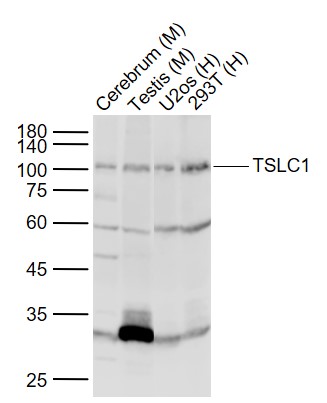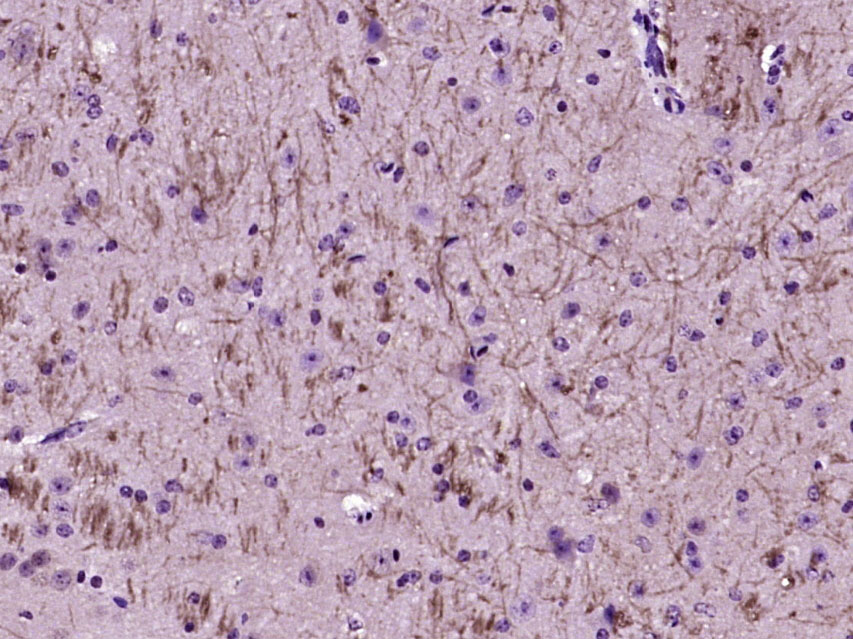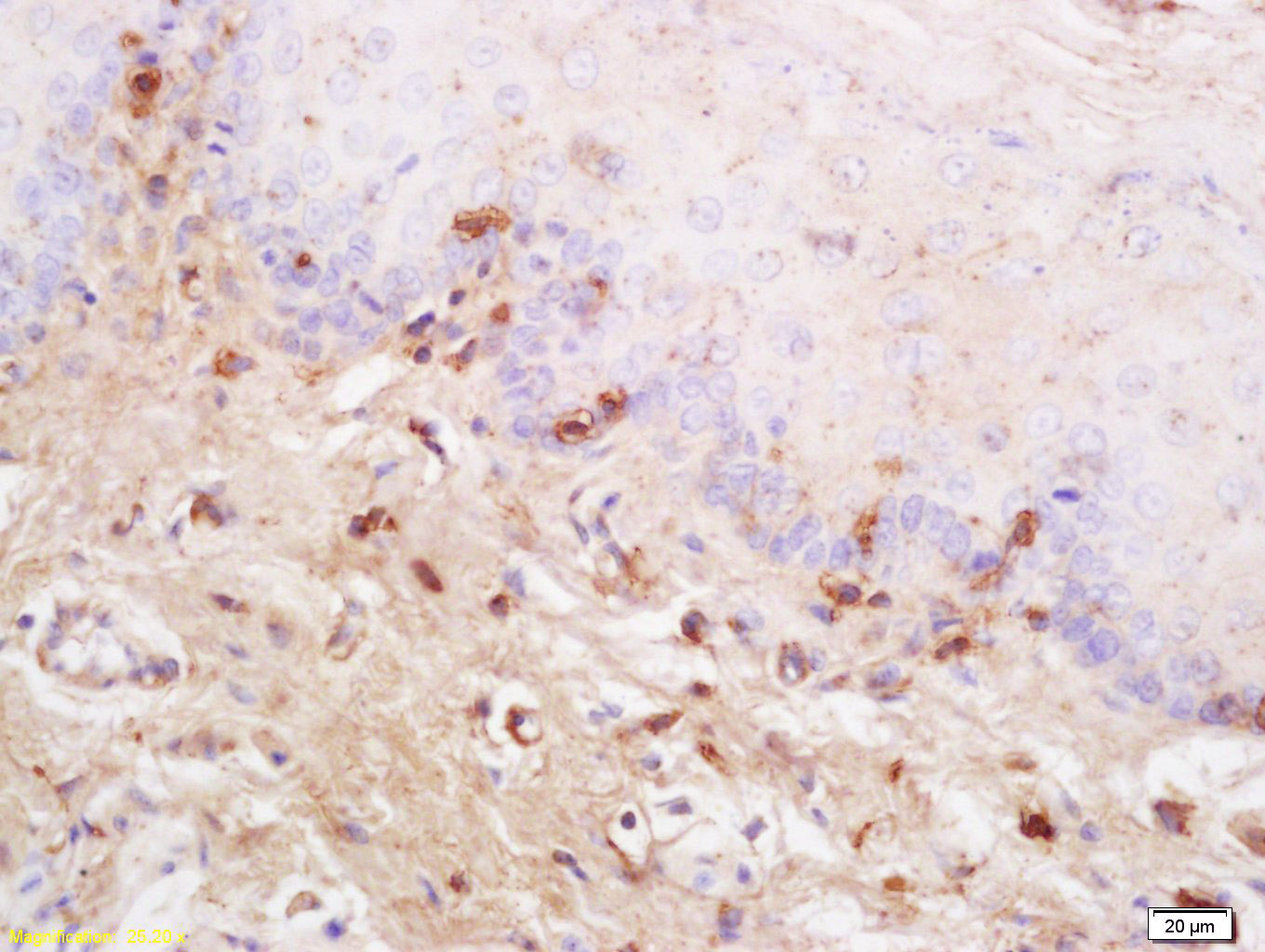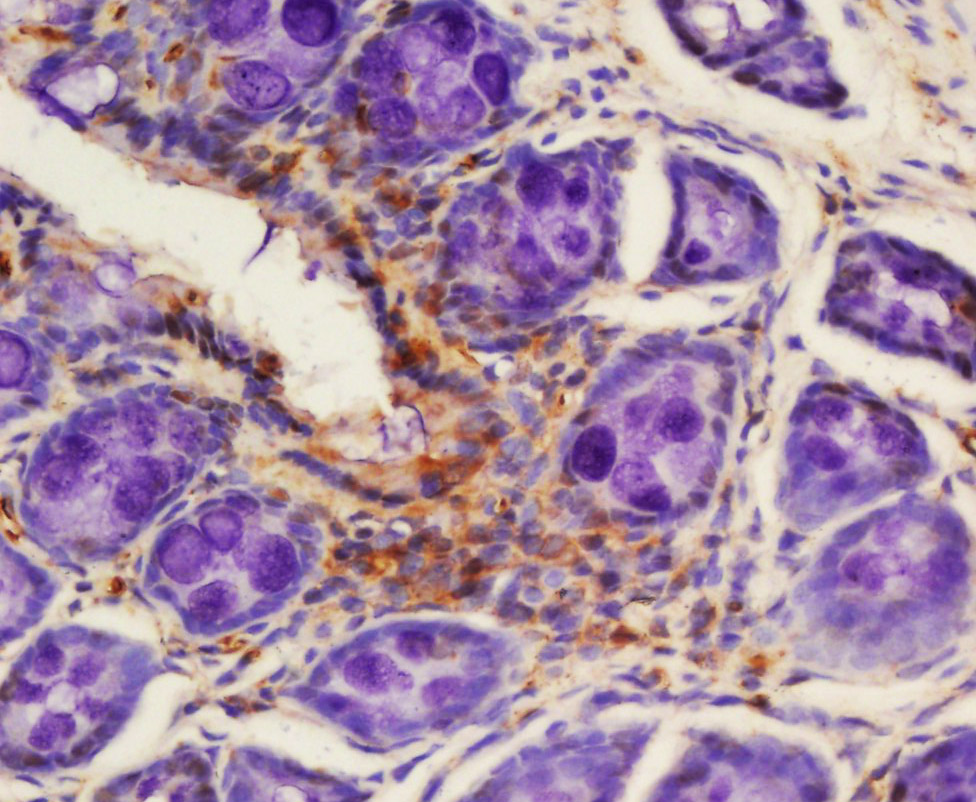
Rabbit Anti-TSLC1 antibody
CADM1; BL2; Cadm1; CADM1_HUMAN; Cell adhesion molecule 1; IGSF4A; Immunoglobulin Superfamily Member 4; NECL-2; NECL2; Nectin like 2; Nectin-like protein 2; RA175; SgIGSF; Spermatogenic immunoglobulin superfamily; ST17; sTSLC 1; Synaptic cell Adhesion Mole
View History [Clear]
Details
Product Name TSLC1 Chinese Name Cell adhesion molecule1抗体 Alias CADM1; BL2; Cadm1; CADM1_HUMAN; Cell adhesion molecule 1; IGSF4A; Immunoglobulin Superfamily Member 4; NECL-2; NECL2; Nectin like 2; Nectin-like protein 2; RA175; SgIGSF; Spermatogenic immunoglobulin superfamily; ST17; sTSLC 1; Synaptic cell Adhesion Molecule; SynCAM; SynCAM1; TSLC-1; TSLC1; Tumor Suppressor in Lung Cancer 1. literatures Research Area immunology Neurobiology Signal transduction Cell adhesion molecule Immunogen Species Rabbit Clonality Polyclonal React Species Human, Mouse, Rat, (predicted: Dog, Pig, Cow, Horse, Rabbit, ) Applications WB=1:500-2000 ELISA=1:5000-10000 IHC-P=1:100-500 IHC-F=1:100-500 IF=1:100-500 (Paraffin sections need antigen repair)
not yet tested in other applications.
optimal dilutions/concentrations should be determined by the end user.Theoretical molecular weight 44kDa Cellular localization cytoplasmic The cell membrane Form Liquid Concentration 1mg/ml immunogen KLH conjugated synthetic peptide derived from human CADM1: 65-160/442 <Extracellular> Lsotype IgG Purification affinity purified by Protein A Buffer Solution 0.01M TBS(pH7.4) with 1% BSA, 0.03% Proclin300 and 50% Glycerol. Storage Shipped at 4℃. Store at -20 °C for one year. Avoid repeated freeze/thaw cycles. Attention This product as supplied is intended for research use only, not for use in human, therapeutic or diagnostic applications. PubMed PubMed Product Detail Mediates homophilic cell-cell adhesion in a Ca(2+)-independent manner. Also mediates heterophilic cell-cell adhesion with CADM3 and PVRL3 in a Ca(2+)-independent manner. Acts as a tumor suppressor in non-small-cell lung cancer (NSCLC) cells. Interaction with CRTAM promotes natural killer (NK) cell cytotoxicity and interferon-gamma (IFN-gamma) secretion by CD8+ cells in vitro as well as NK cell-mediated rejection of tumors expressing CADM3 in vivo. May contribute to the less invasive phenotypes of lepidic growth tumor cells. In mast cells, may mediate attachment to and promote communication with nerves. CADM1, together with MITF, is essential for development and survival of mast cells in vivo. May act as a synaptic cell adhesion molecule that drives synapse assembly. May be involved in neuronal migration, axon growth, pathfinding, and fasciculation on the axons of differentiating neurons. May play diverse roles in the spermatogenesis including in the adhesion of spermatocytes and spermatids to Sertoli cells and for their normal differentiation into mature spermatozoa.
Function:
Mediates homophilic cell-cell adhesion in a Ca(2+)-independent manner. Also mediates heterophilic cell-cell adhesion with CADM3 and PVRL3 in a Ca(2+)-independent manner. Acts as a tumor suppressor in non-small-cell lung cancer (NSCLC) cells. Interaction with CRTAM promotes natural killer (NK) cell cytotoxicity and interferon-gamma (IFN-gamma) secretion by CD8+ cells in vitro as well as NK cell-mediated rejection of tumors expressing CADM3 in vivo. May contribute to the less invasive phenotypes of lepidic growth tumor cells. In mast cells, may mediate attachment to and promote communication with nerves. CADM1, together with MITF, is essential for development and survival of mast cells in vivo. May act as a synaptic cell adhesion molecule that drives synapse assembly. May be involved in neuronal migration, axon growth, pathfinding, and fasciculation on the axons of differentiating neurons. May play diverse roles in the spermatogenesis including in the adhesion of spermatocytes and spermatids to Sertoli cells and for their normal differentiation into mature spermatozoa.
Subunit:
Homodimer. Interacts with CRTAM and EPB41L3/DAL1. The interaction with EPB41L3/DAL1 may act to anchor CADM1 to the actin cytoskeleton. Interacts via its C-terminus with the PDZ domain of MPP3 and the PDZ domain of MPP6.
Subcellular Location:
Cell membrane; Single-pass type I membrane protein. Note=Associates with perinuclear and plasma membranes in vivo. Localized to the basolateral plasma membrane of epithelial cells in gall bladder.
Tissue Specificity:
Highly expressed in colon, kidney, prostate, intestine and activated lymphocytes. Expressed at much higher levels in the renal cell cancers than in surrounding normal kidney tissue. Moderately expressed in pancreas, ovary and testis.
DISEASE:
Defects in CA12 are the cause of hyperchlorhidrosis isolated (HCHLH) [MIM:143860]. HCHLH is a disorder characterized by excessive sweating and increased sweat chloride levels. Affected individuals suffer from episodes of hyponatremic dehydration and report increased amounts of visible salt precipitates in sweat.
Similarity:
Belongs to the nectin family.
Contains 2 Ig-like C2-type (immunoglobulin-like) domains.
Contains 1 Ig-like V-type (immunoglobulin-like) domain.
SWISS:
Q9BY67
Gene ID:
23705
Database links:
Entrez Gene: 23705 Human
Entrez Gene: 54725 Mouse
Omim: 605686 Human
SwissProt: Q9BY67 Human
SwissProt: Q8R5M8 Mouse
Unigene: 370510 Human
Unigene: 234832 Mouse
Product Picture
Lane 1: Cerebrum (Mouse) Lysate at 40 ug
Lane 2: Testis (Mouse) Lysate at 40 ug
Lane 3: U2os (Human) Cell Lysate at 30 ug
Lane 4: 293T (Human) Cell Lysate at 30 ug
Primary: Anti-TSLC1 (SL6026R) at 1/1000 dilution
Secondary: IRDye800CW Goat Anti-Rabbit IgG at 1/20000 dilution
Predicted band size: 44 kD
Observed band size: 100 kD
Paraformaldehyde-fixed, paraffin embedded (Mouse brain); Antigen retrieval by boiling in sodium citrate buffer (pH6.0) for 15min; Block endogenous peroxidase by 3% hydrogen peroxide for 20 minutes; Blocking buffer (normal goat serum) at 37°C for 30min; Antibody incubation with (TSLC1) Polyclonal Antibody, Unconjugated (SL6026R) at 1:400 overnight at 4°C, followed by operating according to SP Kit(Rabbit) (sp-0023) instructions and DAB staining.Tissue/cell: rat tongue tissue; 4% Paraformaldehyde-fixed and paraffin-embedded;
Antigen retrieval: citrate buffer ( 0.01M, pH 6.0 ), Boiling bathing for 15min; Block endogenous peroxidase by 3% Hydrogen peroxide for 30min; Blocking buffer (normal goat serum,C-0005) at 37℃ for 20 min;
Incubation: Anti-SynCAM/TSLC1 Polyclonal Antibody, Unconjugated(SL6026R) 1:200, overnight at 4°C, followed by conjugation to the secondary antibody(SP-0023) and DAB(C-0010) staining
Tissue/cell: rat colon tissue; 4% Paraformaldehyde-fixed and paraffin-embedded;
Antigen retrieval: citrate buffer ( 0.01M, pH 6.0 ), Boiling bathing for 15min; Block endogenous peroxidase by 3% Hydrogen peroxide for 30min; Blocking buffer (normal goat serum,C-0005) at 37℃ for 20 min;
Incubation: Anti-TSLC1 Polyclonal Antibody, Unconjugated(SL6026R) 1:200, overnight at 4°C, followed by conjugation to the secondary antibody(SP-0023) and DAB(C-0010) staining
References (0)
No References
Bought notes(bought amounts latest0)
No one bought this product
User Comment(Total0User Comment Num)
- No comment






 +86 571 56623320
+86 571 56623320
 +86 18668110335
+86 18668110335

